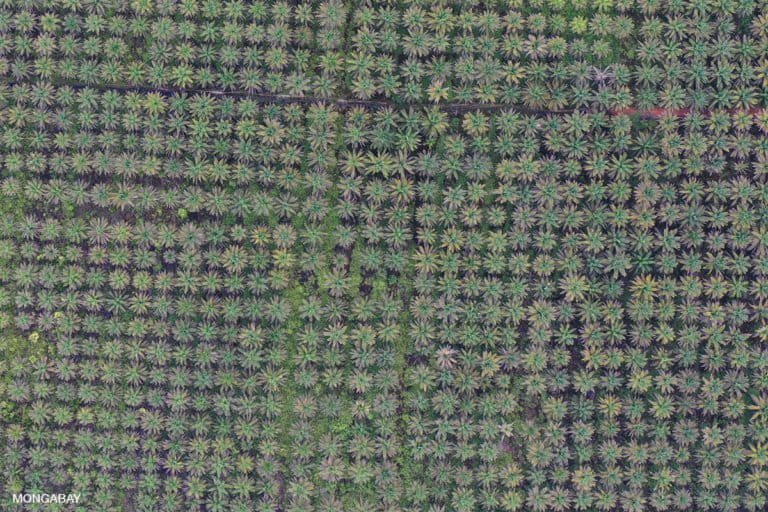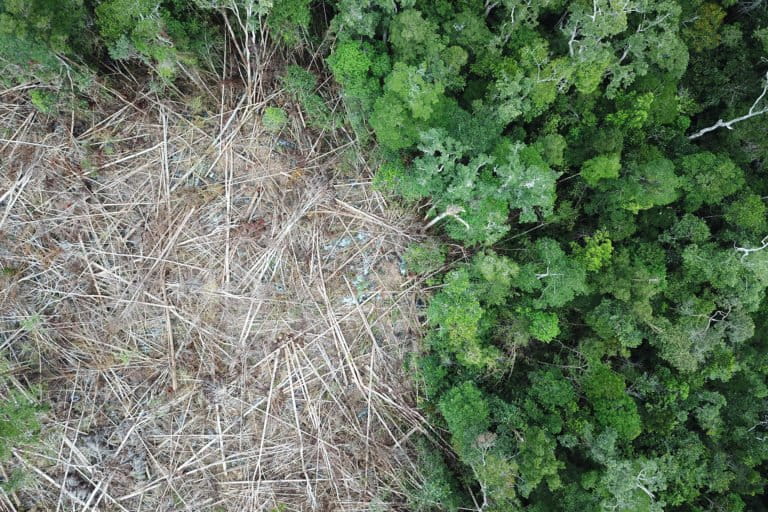- Deforestation and land-use change are the main drivers of greenhouse gas emissions in Indonesia, making the protection of forests crucial in reducing the country’s emissions.
- But an analysis by academics finds a huge swath of forest can still potentially be cleared because it lies within logging and plantation concessions, with few requirements for concession holders to conserve them.
- The analysis finds the country can easily fall short of its pledged emissions reduction goal if these forests are allowed to be cleared, which looks increasingly likely under the provisions of a deregulation bill expected to be passed soon.
- Experts say the government should make it mandatory for concession holders to assess the conservation and carbon stock values of their land and to conserve it accordingly.
JAKARTA — Indonesia has little wiggle room to keep clearing its forests if it’s to meet its emissions reduction goals, and will need to step up the conservation of even non-protected forests, experts say.
The government plans to cut emissions by 29% from the business-as-usual scenario by 2030. The vast majority of its emissions come from deforestation and land-use change, so to meet the target it will have to scale back those forestry-related emissions by 70%, according to an analysis of official data by the Bogor Institute of Agriculture (IPB).
But a key obstacle to doing that, says Rizaldi Boer, the director of IPB’s Center for Climate Risk and Opportunity Management in Southeast Asia and Pacific, is that much of the standing forest has already been parceled out to plantation and logging firms and can be cleared at any time. Pulpwood logging concessions hold 2.92 million hectares (7.22 million acres) of natural forest, and oil palm plantations have 1.44 million hectares (3.56 million acres).
“Of course if all these concessions are converted into agricultural plantations and industrial forest plantations, there would be 4.3 million hectares [10.6 million acres] of deforestation,” Rizaldi said.
That exceeds the cap of 3.96 million hectares (9.79 million acres) that IPB calculates Indonesia must stick below to meet its goal by 2030.
Parts of those concession-bound forests are considered of high conservation value (HCV) and/or high carbon stock (HCS), and are therefore by law prohibited from being cleared. But even if they are conserved, there’s another 6.14 million hectares (15.2 million acres) of forest that falls within areas earmarked by the government for its social forestry program. This land is to be demarcated and the titles awarded to local communities.
The combined potential deforestation from these activities, even under HCV and HCS restrictions, would amount to 4.65 million hectares (11.5 million acres), according to the IPB analysis.
“So if all concession owners only conserve protected areas, then we won’t meet our emissions reduction target,” Rizaldi said.

Protecting unprotected areas
Indonesia is home to the world’s third-largest span of tropical rainforest, after Brazil and the Democratic Republic of Congo. When these rainforests are destroyed or degraded, large amount of carbon dioxide (CO2) emissions are released into the atmosphere.
From 2006 to 2016, deforestation and land-use changes in Indonesia released an average of 237 million tons CO2 equivalent (CO2e) annually, making Indonesia one of the largest emitters in the world. That makes preserving the country’s rainforests pivotal in the fight against catastrophic climate change, experts say. Saving these forests is also critical for the survival of the rich biodiversity they host.
Undermining that effort is the fact that HCV and HCS labeling is voluntary and patchwork, said Teguh Surya, the executive director of environmental NGO Madani. He said the government needs to make it mandatory for all concession holders to carry out carbon stock and conservation value assessments of their land. This will determine whether a natural forest has HCS or HCV, and therefore must be conserved.
“Concessions that have already been handed out [by the government] but have high carbon stock have to be protected,” Teguh told Mongabay. “So it’s time to map [all natural forests] to see which areas have high carbon stock, and for the rest, they can be developed. So it’s a win-win solution. Right now, there’s no clear measurement on whether a natural forest can be developed or not, it’s all based on feelings.”

The government also has to determine a threshold for carbon stock that must be conserved, he said. Some companies have adopted the HCV and HCS approach, undertaken in conjunction with sustainability schemes such as the Roundtable on Sustainable Palm Oil (RSPO) and the Forest Stewardship Council (FSC). But the government still doesn’t require it, Teguh said.
“The adoption is voluntary and more because of pressure from the market, but it’s not regulated,” he said.
As a result, when companies wanted to protect HCV or HCS areas within their concessions, they’re faced with a dilemma, he said: they can either clear the areas for development, and violate their sustainability commitments; or they can leave the land idle, thereby risking having their permits revoked for underexploiting their concession.
“There’s no mechanism to return a high carbon stock area inside a concession [back to the state],” Teguh said. “If the companies don’t cultivate the high carbon stock area, then they’re perceived to be not performing and their permits are deemed problematic.”
Madani and five other NGOs have also called on the government to expand a moratorium on issuing new permits for primary forests and peatlands, in place since 2011. The prohibition doesn’t extend to secondary forests, even though many of these areas still contain high biodiversity and tree cover.
An analysis by Madani shows that there are at least 9.5 million hectares (23.5 million acres) of natural forests that aren’t covered by the moratorium, including 1 million hectares (2.5 million acres) of primary forests.
Rizaldi of IPB said concession holders should go the extra mile by conserving not only the protected parts of their land, but also non-protected areas. But he said Rizaldi it would be difficult to get companies to do so.
“That’s especially the case in Papua [in eastern Indonesia], where there’s still a lot of natural forests inside concessions,” he said.
Ideally, he said, 60% to 90% of non-protected forests should be conserved to guarantee that Indonesia meets or even exceeds its emissions target. At the lower end of that range, the IPB analysis shows deforestation within concessions and social forestry areas will be capped at 1.86 million hectares (4.6 million acres), allowing for a generous buffer of deforestation outside those areas — in the form of illegal logging, clearing and encroachment into protected forests — while still keeping within the limit of 3.96 million hectares.

Deregulation bill
The way forest concessions are managed at present is set to be overhauled drastically under controversial deregulation bill now working its way through parliament.
Various permits, such as for industrial forest plantations, non-timber products, and for conservation purposes, will be merged into a single permit, according to Bambang Hendroyono, the secretary-general of the environment ministry.
“Inside [a concession], there could be non-timber products, timber, environmental [services] and many other things,” he said. “We will make it more efficient, so that once [companies] invest, the forest management can be integrated. If there are non-timber products based on local communities [in concessions], [the companies] can manage [them].”
Hariadi Kartodihardjo, a forestry researcher at IPB, welcomed the planned change, saying it could be a breakthrough in how companies manage their concessions and provide opportunities for them to conserve parts of their land without having to apply for a new permit for each activity.
“There’ll no longer be a dichotomy between industrial plantations and natural forests,” he said. “Once a company operates in a forest area, if there’s no forest cover, then it can be planted [with pulpwood trees], and if it’s natural forest, then it’s protected.”
But the deregulation bill also proposes many other changes that would dismantle environmental safeguards and lead to greater deforestation, experts say. Among them is a proposed amendment to scrap a requirement that all regions maintain a minimum 30% of their territory as forest area. Currently, there are 125 million hectares (309 million acres) of forest area nationwide, making up nearly two-thirds of the country’s land mass.

Environment and Forestry Minister Siti Nurbaya Bakar said the minimum requirement would be dropped to give the same opportunities for all regions to develop, especially for regions where the forested area is already less than 30%. Setting a cap, she said, would limit development.
The Indonesian Forum for the Environment (Walhi), the country’s largest green group, says the move will lead to more forest areas being degazetted to allow them to be cleared. Rere Christanto, the director of Walhi’s East Java provincial chapter, said forest cover in that region could drop below the already low figure of 28.5% if the bill is passed.
East Java, Indonesia’s second-most populous province, is home to nearly 40 million people. Its forests have long been cleared for residential and industrial developments. But it’s important to maintain a threshold figure to ensure the sustainability of water sources and to mitigate floods and landslides, Rere said.
“Imagine if the bill is passed,” he said as quoted by radio news agency KBR. “There’s going to be many more industries that don’t obey good environmental management.”
Other worrisome provisions that observers have identified in the bill are those that weaken enforcement against environmental violations, which will allow companies to evade responsibility for fires on their concessions.

At present, concession holders are responsible for any fires that occur on their land, regardless of whether or not they can be proven to have started the fires. The concept has been employed successfully to prosecute a number of companies since 2015, when fires razed 2.6 million hectares (6.4 million acres) of land — an area larger than the U.S. state of Vermont.
By scaling back this measure of liability and only going after companies if they can be shown to have started the fires, the bill will allow for unscrupulous concession holders to cheat the system. This could give rise to even more fires, as companies will be able to deny responsibility and not face any charges.
That in turn could undermine Indonesia’s emissions reduction goal, given that forest fires are a major source of the country’s emissions. Fires from 2015 to 2018 period unleashed 1.87 gigatons of CO2e — the same as Russia’s total greenhouse gas emissions in a year. Fires on peatlands during that period accounted for nearly a quarter of that total, or the equivalent of the emissions from 110 coal-fired power plants, or 91 million cars.
“Forest, land and peat fires that keep happening every year have put Indonesia in a climate crisis disaster,” said Jasmine Puteri, a forest campaigner at Greenpeace Indonesia. “This shows that the government hasn’t been serious in law enforcement and reducing emissions from the land sector.”

Banner image: Rainforest canopy in Kapuas Hulu, West Kalimantan. Image by Rhett A. Butler/Mongabay.
FEEDBACK: Use this form to send a message to the author of this post. If you want to post a public comment, you can do that at the bottom of the page.
